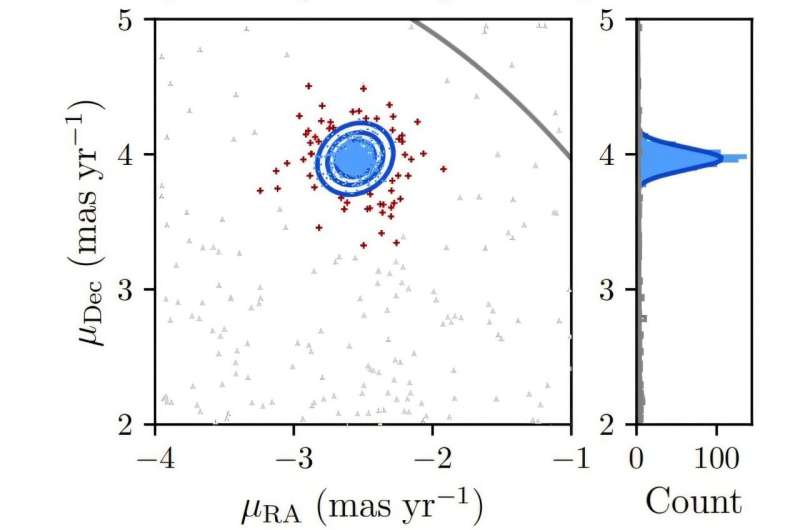Astronomers from the University of Wisconsin–Madison and Harvard–Smithsonian Center for Astrophysics (CfA) have inspected a Galactic open cluster known as NGC 2506 as part of the WIYN Open Cluster Study. Results of the study, published October 14 in The Astronomical Journal, shed more light on the properties of this cluster.
Open clusters (OCs), formed from the same giant molecular cloud, are groups of stars loosely gravitationally bound to each other. So far, more than 1,000 of them have been discovered in the Milky Way, and scientists are still looking for more, hoping to find a variety of these stellar groupings. Expanding the list of known galactic open clusters and studying them in detail could be crucial for improving our understanding of the formation and evolution of our galaxy.
NGC 2506 (also known as Caldwell 54) is a rich, mildly-elongated OC located some 12,700 light years away. The cluster is metal-poor, has a radius of 18.5 light years and is of intermediate-age as it is estimated to be about 2 billion years old.
NGC 2506 is perceived by astronomers as an excellent example of metal-deficient open clusters outside of the solar circle. Moreover, due to its richness, it is a great target for studies on how stars form and evolve as it harbors stars that clearly trace many stages of single-star stellar evolution.
That is why a team of astronomers led by University of Wisconsin–Madison’s Evan Linck decided to perform an extensive radial-velocity (RV) survey of NGC 2506 with Wisconsin–Indiana–Yale–NOIRLab (WIYN) Observatory’s 3.5-meter telescope. The researchers have investigated more than 2,400 stars in the field of NGC 2506. The collected data allowed them to identify 320 proper-motion and radial-velocity member stars of this cluster.
“Our observations are complete (3 or more RV observations) for all proper-motion members brighter than G = 15.5, yielding 320 proper-motion and RV member stars,” the authors of the paper explained.
By analyzing the obtained datasets, it was found that NGC 2506 has a mean radial velocity of 84.29 km/s and a true radial velocity dispersion of 0.54 km/s. The galaxy’s core radius and tidal radius were measured to be approximately 8 and 145 light years, respectively, while its virial mass was estimated to be about 3,400 solar masses.
Furthermore, the researchers managed to obtain orbital solutions for 60 binary stars in NGC 2506, with periods between 1 and 7,580 days. They found that the galaxy has an incompleteness-corrected binary fraction for binaries with periods less than 104 days of about 35% among the upper main sequence stars. In addition, it was found that at least 64% of the 14 known blue straggler stars (BSS) of NGC 2506 are in binary systems.
More information:
Evan Linck et al, WIYN Open Cluster Study. XC. Radial-velocity Measurements and Spectroscopic Binary Orbits in the Open Cluster NGC 2506, The Astronomical Journal (2024). DOI: 10.3847/1538-3881/ad6b1a
© 2024 Science X Network
Citation:
Astronomers investigate the properties of open cluster NGC 2506 (2024, October 31)
retrieved 31 October 2024
from https://phys.org/news/2024-10-astronomers-properties-cluster-ngc.html
This document is subject to copyright. Apart from any fair dealing for the purpose of private study or research, no
part may be reproduced without the written permission. The content is provided for information purposes only.

